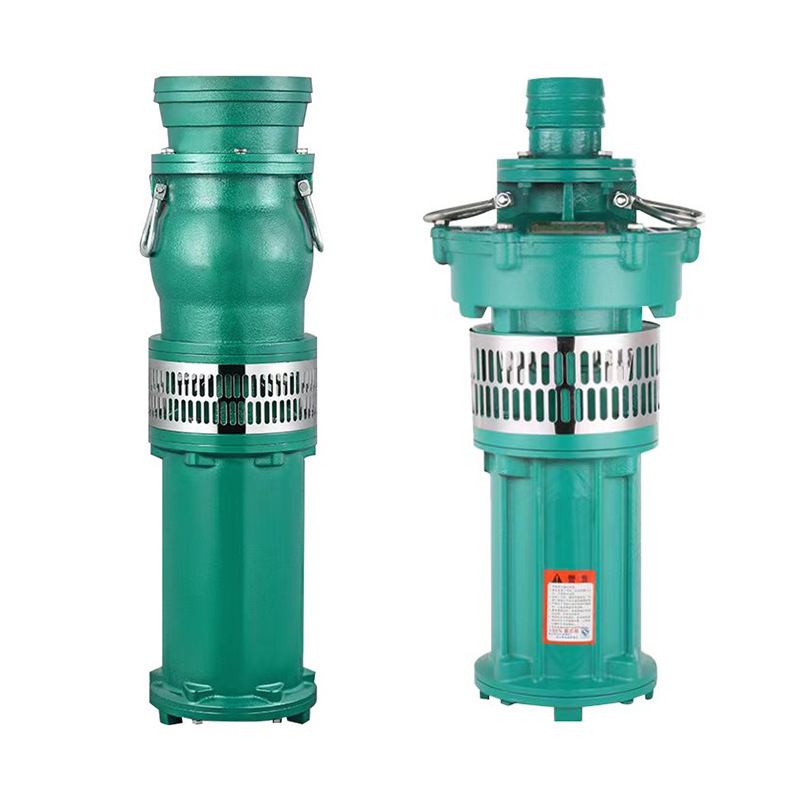Differences Between Oil-Filled and Water-Cooled Submersible Pumps
2025-09-26
Oil-filled and water-cooled submersible pumps differ in several key aspects, making each suitable for specific applications. Below is a comparative overview:
1.Cooling Medium:
Oil-filled submersible pumps use mechanical oil as the internal coolant, whereas water-cooled models rely on water for motor cooling.
2.Environmental Impact:
In the event of leakage, water-cooled pumps do not cause environmental pollution. Oil-filled pumps, however, may lead to oil contamination if a leak occurs.
3.Application Scenarios:
Water-cooled submersible pumps are suitable for drinking water systems due to their non-polluting characteristics. Oil-filled pumps are commonly used in agricultural irrigation, drainage, water tower supply, fountain circulation, flood control, municipal construction, and other industrial and drainage applications.
4.Service Life:
The mechanical oil in oil-filled pumps provides enhanced lubrication, resulting in superior wear resistance and often a longer operational lifespan compared to water-cooled models.
Features of Oil-Filled Submersible Pumps
Oil-filled submersible pumps are integrated pump-motor units designed for shallow water applications. The motor is filled with mechanical oil, which improves the operational conditions of mechanical seals, effectively preventing water ingress. The oil also facilitates efficient heat dissipation, reducing motor temperature rise and enhancing overload capacity. Furthermore, bearings operate immersed in oil, ensuring effective lubrication and cooling, which contributes to extended service life compared to other submersible pump types.
These pumps are typically fully submersible. The oil-filled sealed motor design safeguards against water penetration, maintaining reliable insulation performance.
Advantages of Water-Cooled Submersible Pumps
Water-cooled submersible pumps utilize water within the motor cavity for cooling, offering excellent heat dissipation. Key benefits include:
1.Relaxed Sealing Requirements: Even minor water leakage into the motor cavity generally does not affect normal operation.
2.Efficient Cooling Enables Material Savings: Effective thermal management allows for a more compact and economical motor design.
3.Safe for Potable Water: poses no contamination risk to drinking water sources.
Can an Oil-Filled Submersible Pump Operate Without Oil?
If an oil-filled pump experiences oil loss, it must not be operated. Oil leakage often results from seal failure, which can lead to water entering the oil chamber and potentially damaging the motor. If oil stains are observed near the inlet or cable gland, immediate inspection is necessary. Should the oil chamber contain water, the sealing assembly must be replaced. Similarly, oil seepage at the cable entry indicates internal leakage, often due to a failed cable seal or wiring board crack—these components should be replaced promptly. Always measure motor insulation performance after maintenance and refill with appropriate oil before use.

Which Is Better: Oil-Filled or Water-Cooled?
Submersible pumps are categorized by cooling method: water-cooled, oil-filled, or dry-type. Both water and oil cooling improve heat dissipation, allowing for smaller motor designs and cost savings, though sometimes at the expense of reduced efficiency and higher reactive power. Water-cooled pumps are environmentally friendly and ideal for applications requiring water purity but require attention to electrical insulation. Oil-filled pumps offer robust performance and are well-suited for industrial and agricultural uses with larger three-phase power supplies, though they carry a potential environmental risk in case of leakage.




